Reviving Historic Cultural Waterwork Identity of Delhi- Haryana Ridge : Suraj Kund Complex : Peacock Lake & Anangpur Dam
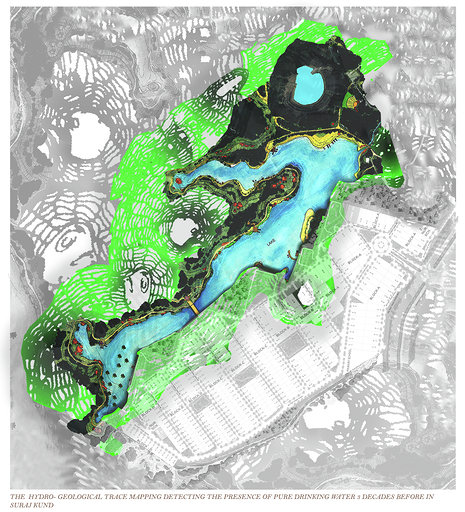
Reviving Historic Cultural Waterwork Identity of Delhi- Haryana Ridge : Suraj Kund Complex : Peacock Lake & Anangpur Dam
EXPLORING EXISTING FLORA- FAUNA WITH TECHNIQUES TO REVIVE THE LAKE PEACOCK, SURAJ KUND & DAM & PROPOSING A
DESIGN INTERVENTION TO RECONNECT HUMANS TO THIS NATURAL WATERWORK
Landscape Architecture Design Series I Ar. Ankur Gautam I Gautam & Gautam Associates I 19 MAY, 2020
HISTORICAL CONTEXT OF SURAJKUND REGION
Surajkund Lake also known as the ‘Peacock Lake’ was originally a water tank and an ancient reservoir and next to it is a semicircle embankment shaped like an amphitheater and the ruins of a Sun Temple on the western banks of the Lake; all builtin the 10th Century by King Surajpal of the Tomar dynasty who avidly worshipped the Sun God.
In the Aravalli hill ranges, which spreads over Delhi and Haryana, where the Surajkund and the Anangpur Dam are located, ancient Stone Age relics have been revealed. The Aravallis, which strikeout in two directions from Delhi exhibits a topography of low and rugged hills. The stratigraphy in the area is considered to consist of reddish rocks and scrub and has the luxuriance of the Stone Age progression. Stone Age material has been unearthed in the region at 43 sites on the road from Delhi to Suraj Kund and south of the Suraj Kund-Faridabad road, Anangpur hills and AnkhirPahari on the road on the low ridge from Faridabad to Surajkund. The Stone Age relics comprise Microliths and lower Paleo lithics.[1]
From a study of the prehistoric findings along the ridges of the Surajkund reservoir, Anangpur Dam, and around Delhi and adjoining parts of Haryana, it has been inferred that the southern hilly area of Delhi and Haryana was the environmentally suited for-historic man to settle here.
The reservoir has been built in the shape of the rising sun with an eastward arc. It is enclosed within a steep embankment made in a semi-circular shape made of stepping stones. Rainfall was intercepted here to create a reservoir of 130 m (427 ft) diameter to meet the water shortage in Delhi. It has an area of 40 ha (99 acres). The reservoir provides a grand spectacle, and in the past, it was the hunting forest resort. It abounds in dancing peacocks. The reservoir is filled up during every monsoon season but remains dry during summer, before the onset of the monsoon rains. The tank underwent major repairs in the 1920s during the British times. [2]

The ecological disaster that is causing the rapid depletion of groundwater in the Aravalli hill range between Tughlaqabad andGurugram via Surajkund due to indiscriminate mining has invited the attention of the Supreme Court of India through the efforts of an environmental activist. This activity is also stated to be affecting the adjoining Asola Forest and Wildlife Sanctuary. Consequent to a writ petition filed by the Delhi Ridge Management Board, the Supreme Court has asked the Haryana government “to stop all mining activities and pumping of groundwater within a (5 kilometers (3 miles), the radius of the Delhi-Haryana border in the Haryana Ridge and in the Aravalli hills.
As evident from the previous blog: HISTORIC CULTURAL WATERWORK IDENTITY OF DELHI- HARYANA RIDGE: SURAJ KUNDCOMPLEX: PEACOCK LAKE & NAGPUR DAM, it is not hidden the havoc human civilization have dawned upon the historic-cultural waterworks identity of Delhi- Haryana Ridge: Suraj Kund, Lake Peacock & Anangpur dam.
(to read about the historic Cultural waterworks identity of Delhi- Haryana Ridge: Suraj Kund complex & factors responsible for its deterioration )
The Delhi Ridge has lost its peripheral runoff, and as a result the water bodies fed by Delhi Ridge like Suraj Kund, Lake Peacock, Anangpurdam, are suffering and are losing their identity. There is an utmost need for the revitalization of these water bodies which is important not only from the microclimatic point of view but also is an essential tool for the replenishment of the groundwater resources. The groundwater resources with the pace of deterioration of water bodies on one hand and excessive abstraction on the other hand, are getting depleted quickly and have acquired a continuous declining trend.
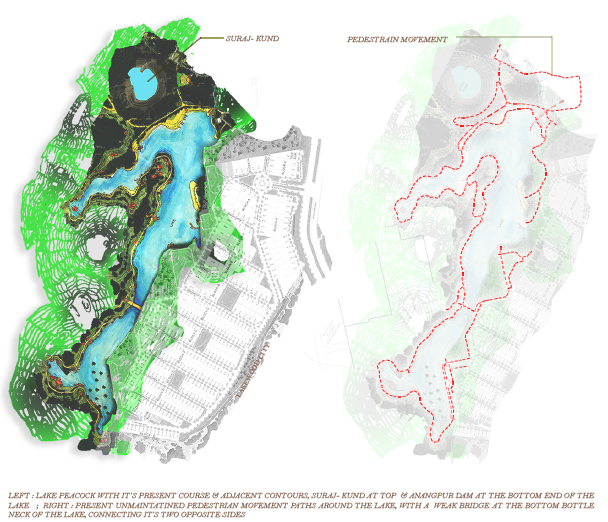
As evident from the le image above, the Lake gets replenished during monsoons for a maximum of a week and that also to about50% shrink profile than that of the 1990s. Also, the proximity development of Lakewood city hinders the norms by the environment committee. Right image demarcates a treacherous, yet pedestrian accessible path around the lake edges, with a weak bridge connecting two sid
es of the lake at the bottleneck.
LAKE AND SURAJKUND COMPLEX FLORA & FAUNA
Surajkund complex & its context is rich with flora & fauna, with Asola Wildlife Sanctuary being just a few Km in proximity to this waterworks. The fauna, particularly those found in abundance here are: Rabbit, Peacock, Monkey, Nilgai, Cow, Beagle, and Fox.
The majority of flora includes Indigo plant (INDIGOFERA TINCTORIA LINN ), Dhok Tree (ANOGEISSUS PENDULA EDWEG): a hardy tree that grows easily on mountains, Desert Date Tree (BALANITES FOXBURGHI PLANCH): Spiny Evergreen tree, GhafTree (PROSOPIS SPICIGERA LINN): generally found in dessert & rocky terrains & Mustard Tree ( SalvadoraPersica L ): a tree with weeping profile, generally found in rocky & desert terrains.

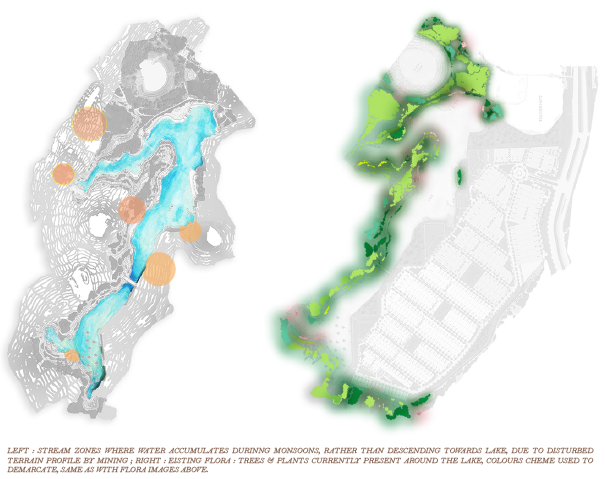
The above images concretize the formation of water collection pockets around the lake, due to disturbed terrain from mining. Also, the vegetation on the right side of the lake has reduced by about 90% within a decade, the recent rapid urbanization & new township development in proximity being the reason for the same.
METHODS OF LAKE & KUND RESTORATION
It is of utmost importance that following pointers must be considered before initiation of the revitalization of Peacock Lake & Suraj- Kund:
i. The complete Watershed of the Surajkund Lake must be obtained using old records of maps and literature.
ii. The impact on original watershed due to Urbanization must be redefined and redesign
iii. The drainage system of the Latest watershed with mixed drainage combinedly such as manmade stormwater drain due to urbanization and natural drainages such as nallah and gullies must be combined together to get the proper amount of runoff to Suraj Kund Lake.
iv. The Rainwater Harvesting Master Plan with the pace of development of the surrounding area at least for 50 years’ future growth must be taken for the Feasibility and Design of Rainwater Harvesting master Plan.
v. The Four Zones of the Surajkund Lake must be replenished as per the latest watershed using Rain Water harvesting MasterPlan.
vi. The Desilting and Evaporation and Evapotranspiration losses must be controlled using Check dams, Cascades, and Non- Evaporative and harmless chemicals.
vii. The Surplus amount of water from the waterlogged areas available in the drains due to monsoon runoff must be considered.
The various LAKE RESTORATION METHODS can be considered under two broad categories:
1) preventive or indirect methods, and
2) ameliorative or direct methods.
The preventive methods are basically the ones that identify the pollutants, reduce their rate of generation, and/or prevent them from reaching the lake. The ameliorative methods involve either the treatment of the wastes before discharge into the lake (outside-lake methods) or direct intervention in the lake (in-lake methods). [3]
It is observed that Lake Peacock is having brown-yellow color water during monsoons, having high mineral rate & highly alkaline & Sodium & Chloride being the dominating chemicals. Also the rate of Eutrophication : (when a body of water becomes overly enriched with minerals and nutrients which induce excessive growth of algae. This process may result in oxygen depletion of the water body. One example is an “algal bloom” or great increase of phytoplankton in a sandy body as a response to increased levels of nutrients), in this lake has increased due to deforestation & loose soil.
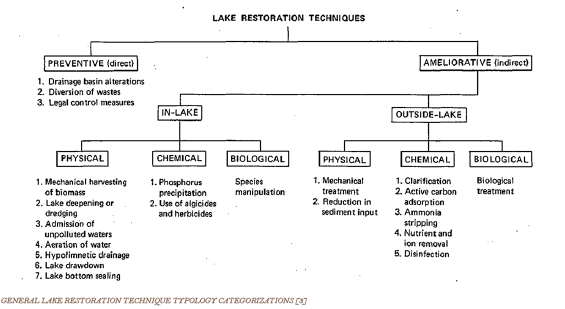
A. LAKE DREDGING OR DEEPENING
Lake Deepening or Dredging. Sediment removal is resorted to for improving diminished recreational potential, reducing the internal cycling of nutrients, removing any toxic sediments, and reducing nuisance aquac macrophyte growth. Sediment-regenerated phosphorus adds considerably to the phosphorus loading in lakes.[3]
Sediment removal for deepening shallow lakes like Peacock Lake may become necessary to uses for which it was designed and built. The conventional hydraulic dredges are commonly used. This is resorted to reducing the internal cycling of nutrients, reducing the microphyte growth & the Eutrophication. Recent revival case studies show some increase in groundwater inflow after the dredging of some similar lakes in the nearby regions.
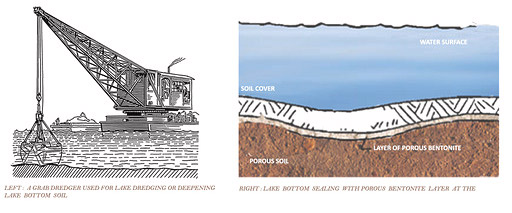
B. LAKE BOTTOM SEALING
To reduce or prevent the nutrient release from lake bottom sediments under anaerobic conditions, the sediment can be covered with Bentonite, usually 0.1-mm thick. Also, to prevent loss to the ground, Lake bottom sealing used. Bentonite swells10 to 12 times of its dry state in water, sealing the lake bottom through a semi-permeable membrane, which allows the exchange of necessary minerals from the lake bed to the lake for micro- life survival at the lake bottom.
C. THERMAL DESTRATIFICATION & AERATION
The DO deficiency during summer occurs mainly because of the decomposition of organic material in the hypolimnion and the thermal stratification, which restricts the movement of cold, dense water in the hypolimnion to the overlying waters in the metalimnion and epilimnion. When the DO levels fall close to zero, more phosphorus is released from the sediments under the prevailing anaerobic conditions. These hypolimnetic waters can be oxygenated and circulated by artificial destratification
and hypolimnetic aeration.[3]
With an increased oxygen level in the hypolimnion, there is a reduction in the release of nutrients from the bottom sediments. The range of benthic populations is extended to the profundal region which was once anaerobic; there is a reduction in surface water temperature and hence a reduction in the evaporation rate, water clarity is increased, and winter fish kills may be avoided by aerating water during winter. [3]

D. RAINWATER FILTERATION
The Rainwater which has been collected in the Lake & directed towards the Kund, can be Filtered through a Rainwater filtration unit attached right at the edge of the lake connecting the kund. This will ensure freshwater in the kund. For this, the filtration unit includes the following layers, water after passing through which will get purified for daily use: COURSE GRAVEL – FINE SAND – CHARCOAL – COARSE GRAVEL.

E. WATAIR
Water is a technology that can be used to extracts moisture & humidity from atmosphere & turns it into freshwater. It’s an inverted pyramid array of panels that collects dew from the air at any climate. The panels are flexible, easy to collapse when not in use, and readily available to provide shade and even some shelter. The central pipe which collects the water can then be connected directly to the lake &kund.
F. RECHARGING THE SURROUNDING GROUNDWATER TABLE
Afforestation is the best practice to recharge the surrounding groundwater table about the lake. For this, the vegetation & trees that recharge groundwater should be planted at the locations where the groundwater level is lower than desired. In thisAravalli region, Three such trees shall be planted in abundance to recharge the groundwater: KHEJRI, BORDI, BABOOL TREE.
Apart from all these measures, also according to the present contour survey of land surrounding the lake & kund, efforts shall be made to earth fill the depressions & valleys where water collects, so that the original catchment slope of adjacent soil can be achieved towards the lake catchment area. On Government & key decision-making committees lie a major responsibility to strictly prohibit & issue day to day surveillance notices in these zones to ban mining & illegal encroachments in these zones.
At a personal level, the residents should highlight this evident landscape issue in group discussions, on social media,generating a sense of awareness & responsibility in bringing back their cultural & local historic landscapeidentity back to life.If possible, on weekends & free days, we can start afforestation by planting tree saplings in zones devoid of vegetation to reducethe heat island effect & soil erosion, further improving the oxygen levels of the region.
CULTURAL & FUNCTIONAL DESIGN INTERVENTIONS
For decades, this landscape marvel has been subdued by the effects of mining & encroachments, breaking the connection ofthis historic waterworks from the locals as well as the visitors. Once the waterworks is revived, it is necessary to make peopleaware about the rich cultural & functional history it is for the locals as well as for the country, making them realize thepainstaking conditions it passed through & the processes through which it is bought back to life. This will not only generate asense of consciousness, but also a sense of responsibility of the people to preserve their landscape heritages & surroundinglandscapes in everyday life, after viewing how devastating their unethical activities can lead to.
This can be achieved by a water & light show at the surajkund which will project the rich history of the place reflecting the auraof old days, the ill effects of humanity, revival story & connection of people with nature. This will further lead to generation ofa human- nature connection , making humans more inclined towards protecting & reviving the nature. The minimal moneycharged, will be used for restoration of other water bodies of the region.
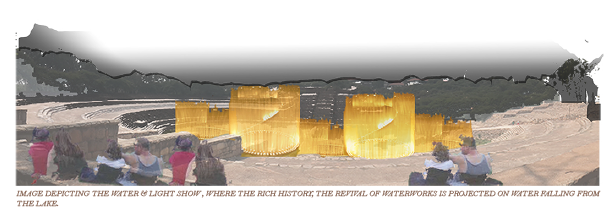
Also, weekend treks & tours can be conducted by the school & college authorities, with various events of afforestation nearbythe lake, to generate sense of awareness & oneness with nature, in younger generations.
Floating Boardwalks can also be introduced in some zones of lake where a bottle neck is forming, to connect two opposite endsof the lake. These can be made of Recycled Plastic drums connected through cable fastener& floating on or above lake surface,with safety handrails made of cables, tied to the same drums. This will reduce the pedestrian distance to be covered around thelake, by providing effective paths of displacement.

Apart from these activities, being in zen with nature & respect for it can be developed only when one connects with nature in physiological& psychological isolation. Meditation, a powerful act helps a person to feel connected with the supreme self, will also aid in harmonizing the nature connection as a form of supreme self, in that moment, discovering nature as an inevitable part of one’s soul & life. Meditation bubbles, form inspired from the water droplet on a leaf, is transparent to meditate amidst nature, while being protected from extreme weather conditions.

Proposal of meditation bubbles right at the valley edges of the lake, will enhance the human- nature connection, with humans meditating amidst the stillness & silence of revived nature, reconnecting them to nature, far away from hustle & bustle of fast pace urbanized life of the contextual regions. These bubbles will be made of recycled & carbon zero footprint materials like Bamboo, timber & Biodegradable Plastics recycled to form the transparent screens, completely biodegradable. Partly transparent floor will give the person option to sit on opaque floor or view the lake beneath him, giving him/ her a sense of being floating in air amidst the nature. The pods will be placed at a good distance from each other so that person can feel alone & in oneness with nature.
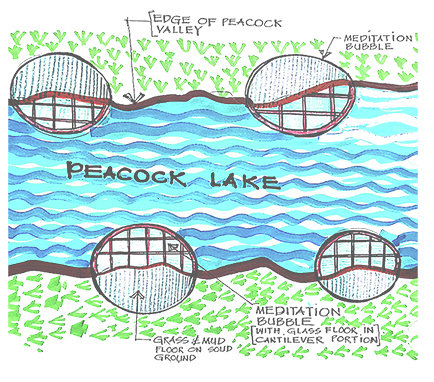
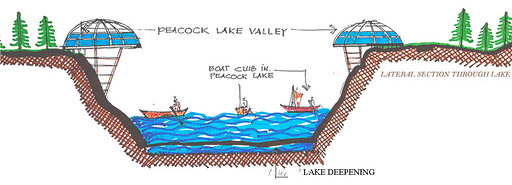
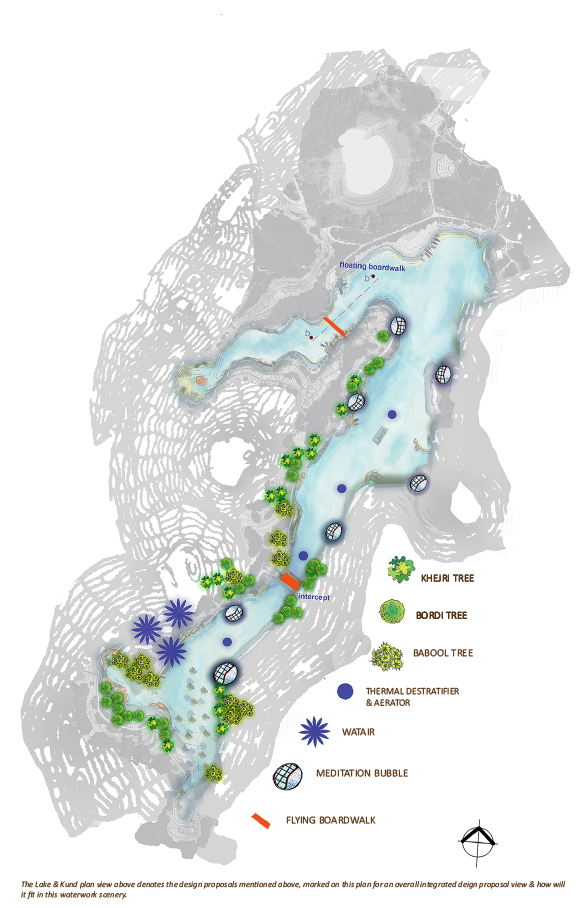
The Anangpur Dam catchment area currently used for farming, shall be cleared off all these activities & Dam structure should be repaired using latest construction technology, to harvest rainwater in abundance, to be released in the lake, reviving the lake &kund through same.
These revival & design proposals can vary based on a person’s perception & their ideology of an ideal landscape revival & design guidelines. However, each person reading this blog should discuss & highlight t his issue with their fellow mates, teachers & family & should pledge to protect & take measures at personal level to revive & celebrate such historic identity waterworks of our society. Generating a global awareness & consciousness regarding this matter can lead to an effective resolution of this dispute, reconnecting humans with this landscape wonder.
Click link :
https://gngindia.com/blogs/historic-cultural-waterwork-identity-of-delhi-haryana-ridge-suraj-kund-complex-peacock-lake-anagpur-dam/
( to read about the historic Cultural waterworks identity of Delhi- Haryana Ridge : Suraj Kund complex & factors responsible for it’s deterioration )
REFERENCES :
[1] Singh, Upinder (2007). Delhi: Ancient History. Preliminary Report on the stone Age of the Union territory of Delhi and Harayana. Berghahn Books. pp. 6–7 in 227.
[2] J. F. Blakiston (2007). 11- Annual Report of the Archaeological Survey of India 1924–1925.
[3](3) Krishan P. Singh, (November 1982), LAKE RESTORATION METHODS AND FEASIBILITY OF WATER QUALITY MANAGEMENT IN LAKE
FOR DETAILED INSIGHT TO OUR LANDSCAPE PROJECTS, VISIT : https://gngindia.com/architects/landscape/
Developed by Abacus Desk

